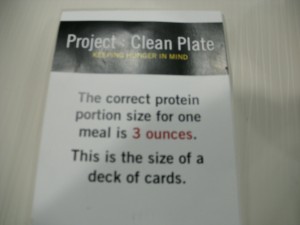Nutrition Labels May Change College Students’ Food Choices
Author: Phillip Martin | Filed under: Local stories, Localizing story, Science, Health, Environment, Spring 2012, Student ContributorBy Phil Martin
Recent federal legislation could lead to local college students making better food choices and controlling their weight.
BGSU and other colleges are posting their nutritional information in their dining halls and online to encourage healthier food consumption, following the Patient Protection and Affordable Care Act.
The act requires all restaurant chains with 20 or more locations to post their calorie information on their menus.
Daria Blachowski-Dreyer, a registered dietician, works closely with BGSU Dining Services and what it’s doing with nutritional labeling.
“Posting nutritional information gives students a point of reference and a means of comparison,” Blachowski-Dreyer said in an email. “Much like everything else, healthy eating is a choice.”

This sign in Carillon Place, an all-you-care-to-eat dining facility at BGSU, suggests the correct portion size of protein for one meal. Photo by Phil Martin.
BGSU does not have nutritional information posted at its dining locations, but it is on the dining service’s website, Blachowski-Dreyer said.
Dining Services does not have a target completion date to begin displaying the information in the dining halls, she said.
The addition of the two all-you-care-to-eat facilities makes nutritional labeling complicated, Blachowski-Dreyer said, because the portion size dictates the nutritional value.
“If you have ever watched your fellow diners, there is definitely a knowledge gap when it comes to appropriate portion size,” she said.
Mary-Jon Ludy, an assistant professor of clinical nutrition at BGSU, studies patterns of weight gain in college freshmen.
“If you can keep serving yourself more and more … It does get a little more convoluted,” she said.
It might be more effective if food servings are portioned out for people like they are in restaurants, she said.
“If you go to Panera, and they have their calorie information up, you’re getting the sandwich or you’re just getting the soup. So, it’s a known portion size,” she said.
She also said she hopes that nutrition labeling will reduce the typical college weight gain. Even a five-pound weight gain can lead to a risk of having hypertension, high blood pressure or high cholesterol, she said.
Even if the labeling is able to make small differences in weight gain, it can make a difference, Ludy said.

This sign in Carillon Place warns students to limit their portion sizes so they won't get too full. Photo by Phil Martin.
The amount of nutritional information students see determines how they stay within their dietary guidelines, she said. Posting calories, fats and proteins is too much; calorie posting is enough, she said.
Labeling can be tricky too, Ludy also said, because there’s the question of whether consumers understand it or not.
A 2008 study in the International Journal of Behavioral Nutrition and Physical Activity looked at the effect of posting calorie information in a dining hall at The Ohio State University.
The dining hall posted nutritional information on its menu boards for two weeks. Before the study, students selected an average of 646.5 calories per entrée. The average decreased by 12.4 calories per entrée on the study’s first day. Overall, the review suggested little to no effect on calorie ordering and consumption.
Additional research is needed to confirm whether labeling may have an impact on purchasing patterns of diverse demographic groups and whether consumers understand them, according to the journal Healthy Eating Research.
Albert Talcott, 20, a sophomore at BGSU, said he would be more self-conscious because of nutritional labeling.
“I’d try to eat healthier because I’d know what I’m eating,” Talcott said.
It’s good to plan ahead, especially for people with dietary needs, he said of BGSU’s online nutritional information. If you’re trying to stay on a diet, you can calculate what you’re eating, he said.
Ludy said college students may not decrease their calorie intake if dining halls continue to label as restaurants do. Dining halls could label healthier foods, like apples and broccoli, with five stars and label foods like cake with one star, she said. This could be friendlier to college students, she said.
Tags: BGSU Dining Services, College Dining, Food, Nutrition Labels, patient protection and affordable care act, Phil Martin